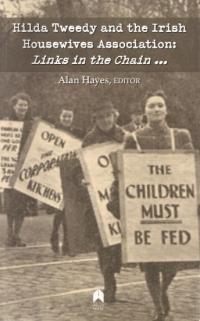Hilda Tweedy and the Irish Housewives Association: Links in the chain . . .
Published in 20th Century Social Perspectives, 20th-century / Contemporary History, Book Reviews, Celtic Tiger, Issue 5 (Sept/Oct 2012), Reviews, Volume 20
Hilda Tweedy and the Irish Housewives Association: Links in the chain . . .
Alan Hayes (ed.)
(Arlen House and Syracuse University Press, $20)
ISBN 9781851320332
‘History is the new sex, it is everywhere’, I am reliably informed by a fecund economist. This new book, carefully edited by Alan Hayes of Arlen Press, who also published Margaret Mac Curtain’s Ariadne’s thread (reviewed in HI 16, Sept./Oct. 2008), concentrates on vital socio-economic matters. While the ‘sexy history’ is concerned with commemoration of political events, this is a book about the everyday lives of Irish people in mid-twentieth-century Ireland. The Irish Housewives Association might not be sexy but it saved lives, particularly young lives. Hilda Tweedy established the IHA in 1942 in the midst of great deprivation, when one child in twelve died before its first birthday. These realities are explained in many of the essays, though the most impressive contributors are those who focus on the facts as opposed to their own perceptions of events. The Irish Housewives Association was so important that it had its own spy, a housewife from Crumlin who was very concerned about communists. She wrote lengthy and entertaining letters between 1940 and 1972 to Archbishop John Charles McQuaid, who was particularly suspicious of multi-denominational organisations like the IHA. The two progenitors of women’s history in Ireland, Mary Cullen and Margaret Mac Curtain, explain the historical context of changing women’s lives in this volume. Mary Cullen’s Telling it our way: essays in gender history, also to be published by Arlen Press later this year, will add to our knowledge and understanding of women’s lives. Cullen’s lengthy article in this collection is the perfect introduction to women’s history in Ireland. She begins with the nineteenth-century politicisation of both men and women and explains the international dimensions of the suffrage movement. It has been suggested that feminism benefited men as well as women and this argument is enhanced by Cullen’s clarification of the ways in which political activity energised the Irish population in the tumultuous early twentieth century. What is not emphasised is the fact that the most political women in Ireland in the early twentieth century were unionist women. Moving to the post-independence era, Aisling Farrell presents a highly original analysis of the politicisation of women’s movements in mid-twentieth-century Ireland. She emphasises the range of campaigns in which female activists were involved, from children’s rights to care for the vulnerable. Bryce Evans’s outstanding article makes clear the vagaries of the black market during World War II and gives a more realistic picture of people’s lives, particularly those who could not barter. His colleague Sonja Tiernan expands on the importance of housework for the continuation of families and pays tribute to the imagination of housewives. More theoretically, Maryann Gialanella Valiulis proposes that the construction of womanhood tended in the 1920s and ’30s, as well as thereafter, to define women by their home duties. She astutely suggests that the IHA ‘did not deny either women’s public or private identity’ but ‘embraced both’. Diarmaid Ferriter argues that children’s health was more impressive than the infant mortality facts of the time. He informs us that the IHA exposed the class basis of much of the contemporary commentary on women’s rights. The ‘rip-off Republic’ existed long before the Celtic Tiger.Caitriona Clear explains the opportunities as well as the restrictions facing women and gives agency to a generation of women who have tended to be subsumed between two women’s movements in the 1910s and 1970s. That middle generation experienced much change, especially in terms of job opportunities and late marriage (often an opportunity to gather a nest egg), and their gradual move from domestic work to clerical employment is one of the noiseless revolutions of mid-twentieth-century Ireland. In a perceptive piece, Margaret Mac Curtain, one of Hilda Tweedy’s closest friends, explains that Tweedy, as the daughter of a Church of Ireland clergyman, like Dr Kathleen Lynn and Justice Catherine McGuinness, ‘came from a minority, which has played a significant role in defining the nature of Irish feminism’. Noisy revolutions, for universal suffrage and the fight for political independence, may be heard, but the silent changes in economic opportunities deserve their historians. Susan McKay praises bloggers who pursue the rights of those excluded, but this kind of communication may lead to unpleasant comments and unascertained assumptions. A fundamental issue is the right to reply, which is difficult with electronic media. All of the contributors to this volume give a voice to these quiet revolutionaries. Hilda Tweedy’s caring personality shines through in these pages, particularly in Rosemary Cullen Owens’s contribution. Mary Ryan, another personal friend, gives us an insight into Tweedy’s practicality. She was no abstract theorist. Her aim was to improve the lives of less fortunate citizens. Mary Robinson acknowledges Tweedy’s role in the more elevated world of human rights. This book will encourage readers to turn to Tweedy’s classic A link in the chain. Whether taking on the black marketeers or patronising politicians, Tweedy was quietly effective. Commemorations may dominate the headlines, but these activists also deserve their days of remembrance. HI
Margaret Ó hÓgartaigh works at Harvard University. Her His Grace is displeased. The selected correspondence of John Charles McQuaid, Roman Catholic archbishop of Dublin, 1940–72, co-edited with Clara Cullen, will be published in November 2012.
















